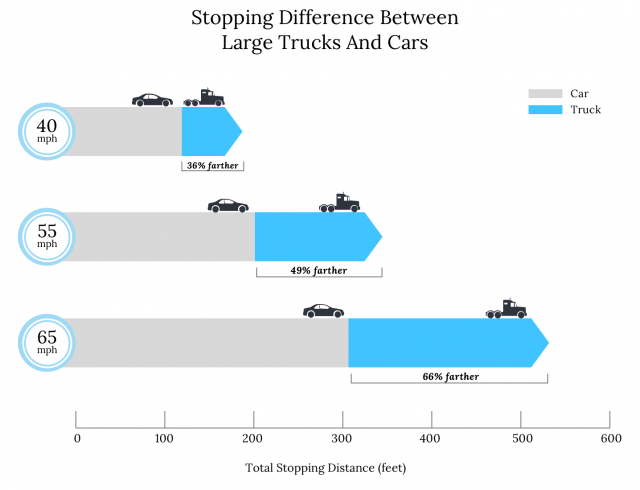Truck Accidents
Accidents happen, but when an accident involves a large truck, the damage can be catastrophic. In 2017, nearly 5,000 Americans were killed in accidents involving large trucks, and tens of thousands more were injured. Truck driver errors, such as speeding and distracted driving, were factors in almost a third of the crashes.

Large trucks are an integral part of our economy. We depend on them to transport food, fuel and other vital goods and commodities to our communities. But truck safety is an ongoing challenge.
Truck wrecks claimed the lives of 4,761 people in 2017 and injured tens of thousands of others. The vast majority of trucks involved in fatal accidents were tractor-trailers, and more than 70 percent of those who were killed were the occupants of cars and other vehicles.
The average car stands little chance against the typical big rig.
A fully loaded semi can weigh up to 80,000 pounds, or 40 tons. The typical car, meanwhile, weighs in at about 3,000 to 4,000 pounds. And because trucks can’t slow down or stop as quickly as cars, trucks tend to hit cars at higher speeds and with greater impact, leaving the car occupants with devastating and often fatal injuries.
Also, because cars sit so much lower to the ground than trucks, cars can easily slide under a semi in a crash. These underride accidents are often catastrophic even at slower speeds. Car occupants end up crushed, trapped or decapitated. Those who survive sometimes have severe head or neck injuries.
Common Causes
Driver error is a contributing factor in most fatal crashes involving large trucks.
Slightly more than half of passenger vehicle drivers involved in fatal truck crashes were cited for driver-related factors in 2017. And truck driver errors were a factor in nearly one-third of those crashes, according to the Federal Motor Carrier Safety Administration. The agency oversees safety practices for truck drivers and other commercial motor carriers.
- Speeding
- Distraction or inattention
- Failure to yield right of way
- Impairment (fatigue, alcohol, illness, etc.)
- Careless driving
Approximately 5 percent of large trucks involved in fatal crashes had vehicle-related problems, such as brake problems or tire issues.
Truck Driver Fatigue
Fatigue is a serious problem in the trucking industry. Truckers work long hours and often don’t get the sleep they need. Many only take short naps when they actually need extended sleep to restore their bodies and minds to optimum functioning levels.
One federal study that monitored 80 truck drivers over 7,500 hours of truck driving found that they averaged only 4.8 hours of sleep per day, and more than half experienced at least one 6-minute interval of drowsiness while at the wheel.
Drowsy driving can have deadly consequences. Being awake for at least 18 hours is comparable to having a blood alcohol content of 0.05 percent, according to the Centers for Disease Control and Prevention. And a comprehensive study of 120,000 crashes involving large trucks found that 13 percent of the truck drivers were fatigued at the time of their accident.
Hours of Service
To combat truck driver fatigue and keep tired drivers off the roadways, the federal government requires certain commercial drivers to comply with what are known as hours-of-service regulations. The regulations place limits on when and for how long a person may drive.
The regulations limit truckers to driving 11 hours during a 14-hour period, and they must take a 30-minute rest break after driving for eight hours. Once truckers have driven 11 hours, they’re required to be off-duty for 10 hours.
The rules also prohibit truckers from being on duty any more than 60 hours during a seven-day period or more than 70 hours during an eight-day period. Once truckers hit that limit, they must take off at least 34 hours before resuming driving and starting a workweek anew.
In theory, the rules are supposed to guarantee that drivers are getting enough rest to stay alert on the road, thereby making the roads safer. But some in the trucking industry say the regulations are actually making things worse.
Some truckers say their bodies aren’t always attuned to the forced downtime and it can be a struggle to find a safe and accessible parking spot to even take a 30-minute break. In that case, the break provides little or no rest and just extends the length of their workday.
Even worse, some truckers end up speeding on the roadways to make up for lost time.
Distracted Driving
Distracted driving is also a serious problem. A 2009 study by the Federal Motor Carrier Safety Administration found that distractions played a role in 71 percent of commercial vehicle crashes and 46 percent of near-crashes.
Distractions are anything that takes a driver’s attention away from driving or draws the driver’s eyes away from the road in front of them. Drivers who send text messages while driving are 23 times more likely to be involved in a “critical safety event,” according to the 2009 distracted driving study.
Other dangerous driver distractions include: interacting with dispatching device, writing something down, using a calculator, looking at a map, dialing a cell phone, reading, personal grooming, reaching for an object and eating.
A tragic example happened in March 2019 when an Indiana semi driver took his eyes off the road to retrieve a sandwich he had dropped. When his eyes returned to the road, the traffic in front of him slowed, but he was unable to stop in time and slammed into the back of another semi.
His passenger, who was riding in the truck’s sleeper berth, was killed in the fiery crash. A passenger in the sleeper berth of the truck he hit sustained injuries to his neck and back.
Distractions outside of a truck’s cab, such as glancing at a passing billboard or building, can also lead to accidents. One study by the Federal Motor Carrier Safety Administration attributed approximately 11,000 truck crashes to distractions outside of the truck.
Work Zone Dangers
Nearly 30 percent of all crashes in work zones involve large trucks, and the number of people killed in these types of accidents is increasing. Over the past five years, more than 1,000 people were killed and 18,000 were injured in work zone accidents involving large trucks.
Work zones are particularly perilous because lanes may be closed, narrowed, or shifted, and traffic may slow or stop suddenly. Other disruptions, including flaggers and work vehicles entering or exiting the traffic flow, can also add to the confusion.
Most work zone crashes are rear-end collisions. Drivers may not realize that trucks need more room to stop than cars do. A large truck that’s traveling 55 mph needs nearly 50 percent greater stopping distance than a car. A truck traveling at a higher speed will need even more room to stop.

Driving Under the Influence
More than 5 percent of the truck drivers involved in fatal crashes in 2017 tested positive for at least one drug. That said, nearly 60 percent of drivers involved in accidents were not tested even though commercial drivers are supposed to be tested whenever they’re involved in a fatal accident.
More than half of the truck drivers who tested positive for drugs were found to have stimulants in their system. The next most commonly detected drugs were marijuana (34 percent) and narcotics (17 percent).
Only 11 percent of those who tested positive were found to have a depressant, such as alcohol, in their system.
Other studies suggest that over-the-counter drug use is also a factor in truck crashes. A 2007 “Large Truck Crash Causation Study” by the Federal Motor Carrier Safety Administration found that over-the- counter drug use was a factor in 17 percent of truck crashes tracked between 2001 and 2003.
Safety Tips for Driving Near Trucks
Some drivers fail to realize that sharing the road with a truck is different from sharing it with another car. When you’re sharing the road with trucks, you should take certain precautions.
The Federal Motor Carrier Safety Administration urges drivers to follow these rules to avoid accidents with large trucks and buses:
- Stay visible.
- Trucks have bigger blind spots than cars. Take care not to drive in these “no zones.” A good rule of thumb is that if you can’t see the truck driver in their side mirror, they can’t see you.
- Pass with care.
- Don’t try and pass a truck until you can see it in your rearview mirror and always give them extra space. Never pass trucks on downgrades, where they tend to pick up speed. If they’re trying to pass you, stay to the right, slow down and give them room.
- Never cut off a truck.
- If you move in front of a truck too quickly, you might be in a blind spot and could get hit. Remember that a truck needs much more space than a car to come to a complete stop in an emergency.
- Don’t tailgate.
- Don’t ride on a truck’s bumper, because it will put you in their blind spot. You also run the danger of sliding under the truck in the event of a crash. Also keep your distance when stopped in traffic in case the truck rolls backward.
- Anticipate wide turns.
- Recognize that trucks need more room to maneuver and may swing wide. Don’t block the box at intersections and never try to squeeze by a turning truck and the curb.
- Be patient.
- Big rigs don’t operate the same way cars do and may take longer to accelerate. Don’t be aggressive, or you could cause a distraction that leads to an accident.
As always, use good common sense on the roads. Stay alert, never drive under the influence, avoid distractions and always buckle up.
What To Do After a Truck Crash
If you are involved in a truck accident, stay at the scene of the accident until help arrives. Leaving the scene could open you up to criminal charges for what’s known as a “hit-and-run.”
If you need to move your car for safety reasons or because it is blocking traffic — and the car is drivable — pull it over to the side of the road. Turn your hazard lights on to ensure other drivers can see you.
Stay away from the traffic to avoid injury. If you or anyone else is injured, call 911 immediately for assistance. Tend to those who need first aid but don’t move anyone who is injured unless the person is in imminent danger.
If you are able, get the names and insurance information of other parties involved in the accident. Also make note of the location of the accident and conditions at the time of the accident, including weather conditions and time of day.
Important information to collect after a truck accident:
- The license plate of the truck and any other identifying information (make/model)
- The truck driver’s license number and employer
- Names and addresses of drivers/passengers
- Insurance company information and policy number
- Names, phone numbers and addresses of any witnesses
If you are able, take photos of the accident scene and damage with your smartphone. This could serve as important evidence. You may even want to record an audio account of what happened but don’t admit or assume fault for the collision. Be sure to get a copy of the accident report when it’s available.
In most situations, you’ll want to seek legal help as soon as possible. Because truck accidents are more complex than other auto accidents, be sure to find an experienced attorney who specializes in truck accident lawsuits.
29 Cited Research Articles
Consumernotice.org adheres to the highest ethical standards for content production and references only credible sources of information, including government reports, interviews with experts, highly regarded nonprofit organizations, peer-reviewed journals, court records and academic organizations. You can learn more about our dedication to relevance, accuracy and transparency by reading our editorial policy.
- Clock. Retrieved from https://www.trucks.com/2018/10/31/heavy-duty-trucking-deaths-racing-clock/
- Adler, A. (2018, October 4). Trucking Fatalities Reach Highest Level in 29 Years. Retrieved from https://www.trucks.com/2018/10/04/large-truck-fatalities-29-year-high/
- Associated Press. (2019, January 4). The Latest: Truck Drive in Fatal Crash Had Several Tickets. Retrieved from https://www.usnews.com/news/best-states/florida/articles/2019-01-04/the-latest-death-toll-in-florida-highway-crash-rises-to-7
- Centers for Disease Control and Prevention. (2003). Truck Driver Occupational Safety and Health: 2003 Conference Report and Selective Literature Review. Retrieved from https://www.cdc.gov/niosh/docs/2007-120/pdfs/2007-120.pdf
- Divine, M. (2019, April 9). Wisconsin semi driver pleads guilty in fatal Lake Elmo crash. He was looking at his phone, charges say. Retrieved from https://www.twincities.com/2019/04/09/wisconsin-semi-driver-pleads-guilty-in-fatal-lake-elmo-crash/
- Federal Motor Carrier Safety Administration. (2007, July). The Large Truck Crash Causation Study — Analysis Brief. Retrieved from https://www.fmcsa.dot.gov/safety/research-and-analysis/large-truck-crash-causation-study-analysis-brief
- Federal Motor Carrier Safety Administration. (2009, September). Driver Distraction in Commercial Vehicle Operations. Retrieved from https://www.fmcsa.dot.gov/sites/fmcsa.dot.gov/files/docs/DriverDistractionStudy.pdf
- Federal Motor Carrier Safety Administration. (2017, March 9). Hours-of-Service Rules. Retrieved from https://www.fmcsa.dot.gov/regulations/hours-service/summary-hours-service-regulations
- Federal Motor Carrier Safety Administration. (2018, August). 2018 Pocket Guide to Large Truck and Bus Statistics. Retrieved from https://www.fmcsa.dot.gov/sites/fmcsa.dot.gov/files/docs/safety/data-and-statistics/413361/fmcsa-pocket-guide-2018-final-508-compliant-1.pdf
- Federal Motor Carrier Safety Administration. (2019, March 13). Large Truck and Bus Crash Facts 2017: Early Release. Retrieved from https://www.fmcsa.dot.gov/safety/data-and-statistics/large-truck-and-bus-crash-facts-2017-early-release
- Federal Motor Carrier Safety Administration. (2019, March 13). Large Truck and Bus Crash Facts. Retrieved from https://www.fmcsa.dot.gov/safety/data-and-statistics/large-truck-and-bus-crash-facts
- Federal Motor Carrier Safety Administration. (n.d). CMV Tips — Driver Fatigue. Retrieved from https://www.fmcsa.dot.gov/safety/driver-safety/cmv-driving-tips-driver-fatigue
- Federal Motor Carrier Safety Administration. (n.d.). Interstate Truck Driver’s Guide to Hours of Service. Retrieved from https://www.fmcsa.dot.gov/sites/fmcsa.dot.gov/files/docs/Drivers_Guide_to_HOS_2016.pdf
- Federal Register. (2015, October 16). Federal Motor Vehicle Safety Standard; Automatic Emergency Braking. Retrieved from https://www.federalregister.gov/documents/2015/10/16/2015-26294/federal-motor-vehicle-safety-standard-automatic-emergency-braking
- Hendricks, M. (2018, September 9). Lethal inaction: As fatal truck crashes surge, U.S. government won’t make an easy fix. Retrieved from https://www.kansascity.com/news/politics-government/article217849815.html
- Indiana State Police Putnamville District. (2019, March 16). Distracted Driving Results in Deadly Accident. Retrieved from https://content.govdelivery.com/accounts/INPOLICE/bulletins/237382b
- Insurance Institute for Highway Safety Highway Loss Data Institute. (2018, December). Large trucks. Retrieved from https://www.iihs.org/topics/fatality-statistics/detail/large-trucks
- Miller, E. (2018, August 15). CVSA Responds to Senators by Deciding to Spend a Day Inspecting Trailer Underride Guards. Retrieved from https://www.ttnews.com/articles/cvsa-responds-senators-deciding-spend-day-inspecting-trailer-underride-guards
- Moore, R.T., Kaprielian, R. & Auerbach, J. (2009, February). “Asleep at the Wheel”: Report of the Special Commission on Drowsy Driving. Retrieved from https://web.archive.org/web/20200330022809/https://sleep.med.harvard.edu/file_download/103
- Moyer, J.W. (2015, August 12). Shocking images of Tracy Morgan crash in NTSB report faulting driver of Wal-Mart truck. Retrieved from https://www.washingtonpost.com/news/morning-mix/wp/2015/08/12/shocking-images-of-tracy-morgan-crash-in-report-blaming-driver-of-wal-mart-truck/?utm_term=.562fe23f69ba
- National Transportation Safety Board. (2015, August 11). Fatigue and Excessive Speed Caused Multi-Vehicle Accident in New Jersey. Retrieved from https://www.ntsb.gov/news/press-releases/Pages/PR20150811.aspx
- National Transportation Safety Board. (2015, October). Truck Fleet Safety — Lessons Learned from Crashes. Retrieved from https://www.ntsb.gov/safety/Documents/SafetyTips_FleetOwners.pdf
- Nationwide. (2014, May 21). How to Share the Road with Semi Trucks & Cyclists. Retrieved from https://blog.nationwide.com/driving-near-trucks-and-bikes/
- Peterman, D.R. (2017, March 21). Commercial Truck Safety: Overview. Retrieved from https://fas.org/sgp/crs/misc/R44792.pdf
- The National Work Zone Safety Information Clearinghouse. (n.d.). Driving Safely in and Around Work Zones. Retrieved from https://www.workzonesafety.org/files/documents/training/fhwa_wz_grant/artba_wz_safe_driving_brochure-508.pdf
- Truck Safety Coalition. (n.d). Automatic Emergency Braking. Retrieved from https://trucksafety.org/automatic-emergency-braking/
- Truck Safety Coalition. (n.d.). Issues. Retrieved from https://trucksafety.org/issues/
- University of Utah Health Sciences. (2017, January 17). How safe is that driver next to you? A trucker’s poor health could increase crash risk. Retrieved from https://www.sciencedaily.com/releases/2017/01/170117083849.htm
- Utah Department of Transportation. (n.d.). Trucks Need More Time to Stop. Retrieved from https://trucksmart.udot.utah.gov/motorist-home/stopping-distances/
Calling this number connects you with a Consumer Notice, LLC representative. We will direct you to one of our trusted legal partners for a free case review.
Consumer Notice, LLC's trusted legal partners support the organization's mission to keep people safe from dangerous drugs and medical devices. For more information, visit our partners page.
844-420-1914
